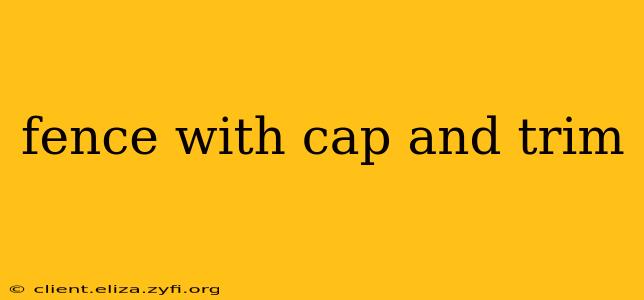A fence isn't just a boundary; it's a statement. Adding a cap and trim to your fence elevates its aesthetic appeal, significantly enhancing your property's curb appeal and adding value to your home. This comprehensive guide will delve into the world of fence caps and trims, exploring their types, benefits, and installation. We'll also address frequently asked questions to ensure you have all the information needed for your fencing project.
What are Fence Caps and Trims?
Fence caps are the protective and decorative coverings placed atop fence rails, while trims are added to the edges of fence boards or posts for a finished look. Both caps and trims protect the wood from the elements, extending the lifespan of your fence. They also contribute significantly to the overall visual impact of your fence, transforming a basic structure into a beautiful and polished feature.
Types of Fence Caps
Several types of fence caps cater to different styles and budgets:
-
Aluminum Caps: These are durable, lightweight, and available in a wide range of colors and styles. They resist rust and rot, making them a popular choice.
-
Vinyl Caps: Offering similar benefits to aluminum caps, vinyl caps are also resistant to weather damage and require minimal maintenance. They come in various colors and styles to match your fence.
-
Wood Caps: While requiring more maintenance than aluminum or vinyl, wood caps offer a classic and natural look. They can be stained or painted to match your fence's style.
Types of Fence Trim
Fence trim options vary depending on your fence's design and your personal preference:
-
Board and Batten Trim: This classic style involves adding vertical boards to cover the gaps between fence boards, creating a clean and sophisticated look.
-
Cope Trim: Cope trim provides a decorative edge to the top of your fence, adding visual interest and protection from the elements.
-
J-Channel Trim: J-channel trim is used to cover the edges of fence boards, protecting them from moisture and giving the fence a neat finish.
What are the Benefits of Using Fence Caps and Trim?
Adding caps and trim to your fence offers numerous benefits:
-
Increased Durability: Caps and trim protect your fence from moisture, UV rays, and other elements, significantly extending its lifespan.
-
Enhanced Aesthetics: They add a finished and polished look, transforming your fence from a basic structure to a beautiful feature of your property.
-
Improved Curb Appeal: A well-maintained fence with caps and trim can dramatically improve your home's curb appeal, potentially increasing its value.
-
Protection from Damage: Caps protect the top rail from damage, while trim protects the edges of the boards and posts.
How Much Does it Cost to Add Caps and Trim to a Fence?
The cost of adding caps and trim to a fence varies depending on factors such as the fence's size, the materials used, and labor costs. It's best to get quotes from multiple fencing contractors to compare prices and find the best value for your project.
How Long Does it Take to Install Fence Caps and Trim?
The installation time depends on the size of the fence and the complexity of the project. Smaller fences might take a day or two, while larger fences could take several days to complete.
Can I Install Fence Caps and Trim Myself?
While possible for those with DIY experience, installing fence caps and trim requires some carpentry skills and tools. If you're unsure, hiring a professional fence installer is recommended to ensure a quality installation and avoid potential damage.
What Materials are Best for Fence Caps and Trim?
The best materials for fence caps and trim depend on your budget, style preference, and the climate in your area. Aluminum and vinyl are popular choices for their low maintenance and durability, while wood offers a more natural look.
Conclusion
Adding caps and trim to your fence is a simple yet impactful way to enhance its appearance and protect it from the elements. By carefully considering the different types available and their benefits, you can choose the perfect options to complement your home's style and increase its value. Remember to factor in installation costs and consider whether to undertake this project as a DIY or hire a professional. With the right choices, your fence will become a stunning focal point of your landscape for years to come.
